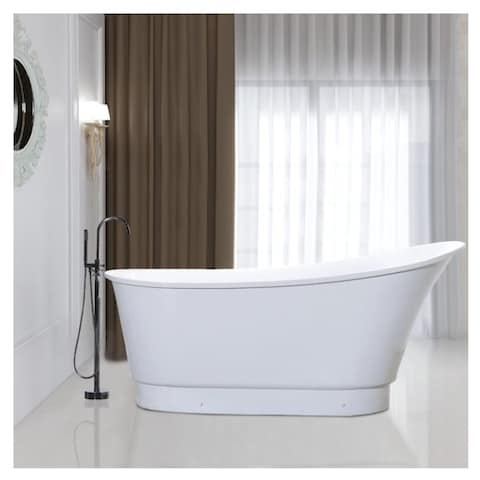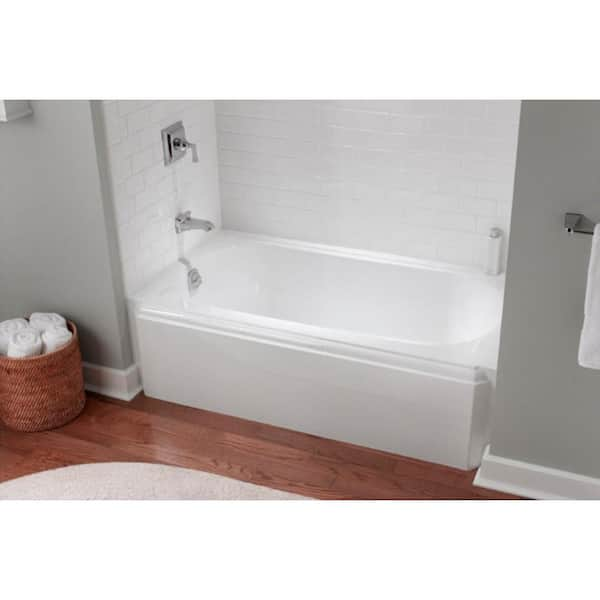How to Install a Bath Tub
How to Install a Bath Tub
Blog Article
They are making several good observations regarding How to Install a Bathtub: Install an Acrylic Tub and Tub Surround as a whole in this content which follows.

Mounting a tub isn't exactly brain surgery, but it does call for solid plumbing, woodworking, and occasionally, tiling skills. Changing an old tub with a brand-new one is likewise a reasonably tough project. If the old bathtub is readily easily accessible, the task can move speedily; if you have to open up a wall to get rid of the old tub and also position the brand-new bathtub, the job is a lot harder. In either situation, the task is within a home handyman's abilities, although you will need an assistant to move out the old bathtub and set in the brand-new one. Ensure you have actually qualified yourself for the work and fit trying it. Rather than working with a professional to take control of a halfway-completed task, it is much better to take into consideration employing one prior to you start. Chances are you might require a professional plumber to make tube connections.
This post will certainly help you set up a brand-new bathtub in your restroom if you have actually currently bought a new bathtub and also don't need to transform the setup of your previous supply of water pipelines.
Your devices and also material checklist must consist of the following:
Removing Old Touches
If you require to change old faucets with brand-new ones as a part of your installation, then the first thing you ought to do is detach the water. After doing so, activate the taps to drain any water staying in the system. The procedure of getting rid of the existing faucets can be fairly problematic due to the restricted gain access to that is typically the instance.
Make use of a basin wrench (crowsfoot spanner) or a tap tool to undo the nut that links the supply pipelines to the faucets. Have a fabric all set for the continuing to be water that will certainly originate from the pipelines. As soon as the supply pipelines have actually been gotten rid of, make use of the very same device to loosen up the nut that holds the faucets onto the bath/basin. You will certainly require to quit the single taps from turning during this procedure. As soon as the faucets have actually been gotten rid of, the holes in the bath/basin will certainly have to be cleaned of any old securing substance.
Prior to going on to fit the brand-new taps, compare the pipe connections on the old faucets to the brand-new faucets. If the old taps are longer than the brand-new taps, then a shank adapter is needed for the brand-new faucets to fit.
Suitable New Touches
If the tails of the new faucets are plastic, after that you will certainly require a plastic port to avoid damage to the thread. One end of the connector fits on the plastic tail of the faucet and also the various other end supplies a connection to the existing supply pipes.
If you require to fit a monobloc, after that you will certainly need decreasing couplers, which connects the 10mm pipe of the monobloc to the standard 15mm supply pipeline.
Next off, position the tap in the mounting opening in the bath/basin making sure that the washers are in place in between the tap and the sink. Secure the faucet in position with the producer provided backnut. As soon as the faucet is safely in place, the supply pipes can be attached to the tails of the faucets. The taps can either be connected by utilizing corrugated copper piping or with typical tap adapters. The previous type should be attached to the tap ends initially, tightening only by hand. The supply pipelines can later be attached to the various other end. Tighten both ends with a spanner after both ends have actually been linked.
Installing the Bath tub
Utilizing the two wood boards under its feet, put the bathtub in the needed position. The wood boards are valuable in evenly spreading out the weight of the tub over the location of the boards rather than focusing all the weight onto 4 small factors.
The next objective is to make sure that the bath tub is leveled all round. This can be accomplished by checking the level and readjusting the feet on the bathtub till the spirit level reviews level.
To mount taps, fit all-time low of the furthest adaptable tap adapter to the suitable supply pipeline by making a compression join; after that do the same for the various other faucet.
Turn on the water as well as examine all joints and brand-new pipework for leaks as well as tighten them if necessary. Fill up the bath tub and additionally check the overflow electrical outlet and the typical electrical outlet for leaks.
Lastly, fix the bath paneling as defined in the manufacturer's user's manual. Tiling and also sealing around the tub should wait up until the bath tub has been utilized at the very least once as this will resolve it right into its final setting.
Planning for the Installation
First of all, the sustaining frame supplied with the bathroom should be fitted (if needed) according to the supplier's instructions. Next, fit the faucets or mixer to the bath tub. When fitting the tap block, it is important to ensure that if the faucet features a plastic washing machine, it is fitted between the bath as well as the faucets. On a plastic bath, it is likewise reasonable to fit a sustaining plate under the taps unit to avoid stress on the bath tub.
Fit the flexible tap ports to the bottom of both faucets using 2 nuts and olives (in some cases supplied with the bathtub). Fit the plug-hole electrical outlet by smearing mastic filler round the sink electrical outlet opening, and then pass the outlet through the hole in the bath. Utilize the nut provided by the maker to fit the plug-hole. Check out the plug-hole outlet for an inlet on the side for the overflow pipe.
Next, fit the end of the flexible overflow pipe to the overflow outlet. After that, screw the pipe to the overflow face which ought to be fitted inside the bath. Make certain you utilize every one of the provided washing machines.
Link the trap to the bottom of the waste outlet on the tub by winding the thread of the waste outlet with silicone mastic or PTFE tape, and also screw on the catch to the electrical outlet. Link the bottom of the overflow tube in a similar manner.The bath need to currently prepare to be fitted in its last placement.
Tiling Around the Tub
In the area where the bathroom satisfies the floor tile, it is essential to secure the joins with a silicone rubber caulking. This is important as the fitting can relocate sufficient to break a rigid seal, causing the water to pass through the wall between the bath and also the tiling, bring about difficulties with wetness as well as possible leaks to the ceiling below.
You can pick from a selection of coloured sealers to blend in your fixtures and fittings. They are sold in tubes and cartridges, and also can sealing gaps approximately a size of 3mm (1/8 inch). If you have a bigger space to fill, you can load it with spins of soaked newspaper or soft rope. Bear in mind to constantly fill up the bathtub with water prior to securing, to enable the movement experienced when the bathtub remains in use. The sealer can split relatively early if you do not think about this activity before sealing.
Conversely, ceramic coving or quadrant ceramic tiles can be used to border the bath or shower tray. Plastic strips of coving, which are easy to use and reduce to size, are also conveniently offered on the market. It is suggested to fit the ceramic tiles using waterproof or waterproof glue as well as grout.
Bathtub Installation
How Important Is A Bathtub To Your Home?
High-quality baths, showers, and other bathroom updates are necessary when considering a smart investment in your home. It’s a room that you go to every day and one that is constantly being used by guests.The bathroom is one of the top trafficked rooms in a home and also one of the most valuable in terms of home resale.
Install Piping Before Tub
You will be using your existing drain and waste vent system, but pipes required include the hot and cold water supply lines and a pipe leading to a shower head. A mixing valve and shower head are also needed. Air chambers may be required.
Position the Tub
Lower the tub into place so that the continuous flange fits against the wall studs and rests on 1’x4' or 2’x4' supports. Anchor the tub to the enclosure with nails or screws inserted through the flanges into the studs.
NOTE: Remember, bathtubs and shower stalls may require support framing. A bathtub filled with water is extremely heavy, so check building codes and framing support before installing the tub.
Assemble Drain Connections
Assemble the bathtub drain connections by connecting the tub overflow with the tub drain above the trap, not beyond it. The trap will have a compression fitting that screws over the arm of the overflow assembly.
Place a Pipe For the Shower Head
First, locate a brass female threaded winged fitting and attach it to a framing support via a screw or a nail. Then run a pipe up the wall for the shower head. Sweat or solder the other side of the brass fitting to the top of the pipe.
Attaching Hot and Cold Water Lines
Attach your water lines for both hot and cold by sweating these directly into the hot and cold ports of the mixing valve. The mixing valve will be how water enters the tub’s system, not by the pipes themselves.
Install the Spout
Extend a piece of 1/2 inch pipe, or whichever length is specified in the manufacturer’s instructions, for the tub spout. Sweat on a male threaded fitting at the end of the pipe or use a brass nipple of the proper length and a 1/2 inch cap.
NOTE: At this point you should have your rough-in plumbing work inspected before proceeding further.
Check For Leaks
Restore the water pressure and check the drain connection and the supply pipes for any sign of leaking.
estore the Bathroom Wall
Replace the wall with moisture-resistant drywall as a base for your wall covering. Seal the joints between the wall and your new tub with silicone caulk as protection against water seepage.
https://www.berkeys.com/2016/12/02/bathtub-installation-dallas/

As a fervent reader about How to Install a Bathtub: Install an Acrylic Tub and Tub Surround, I think sharing that excerpt was really helpful. Sharing is caring. Helping others is fun. We value reading our article about Tools You Need to Install a New Bathtub .
At This Website Report this page